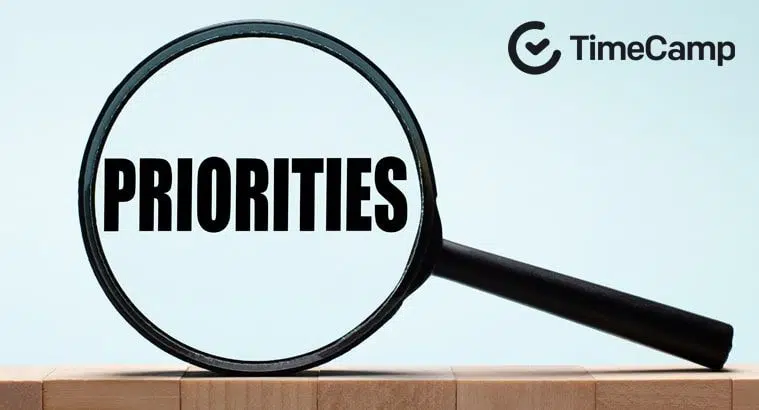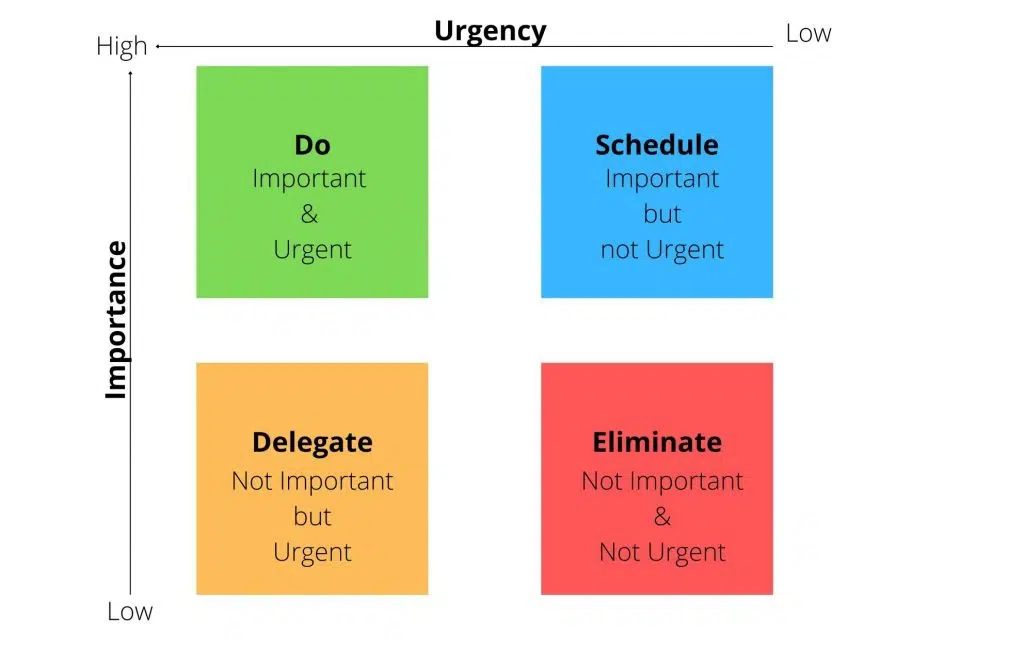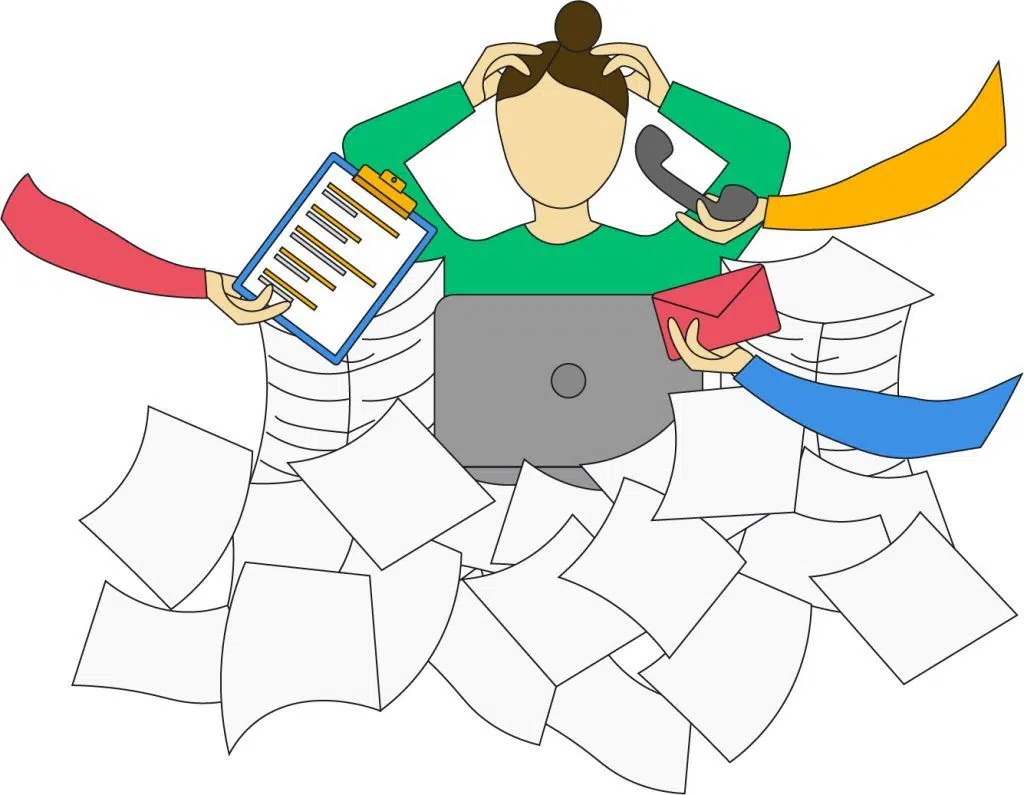How to prioritize work when everything’s important?
-
Kat Ciesielska
- October 20, 2021
- 8 min read

How to prioritize tasks when there is so much work to do? What are the most important tasks to do and what can wait? Is it even possible to finish all the important tasks you’ve got for each day?
Doesn’t matter where do you work, these are questions that you’ve asked yourself at least once a life for sure. Unfortunately, no one taught you at school how to prioritize your work properly.
Learning it may seem time-consuming at the beginning, but it will change your life. When you make the effort required to master prioritizing tasks properly, you will start enjoying work with less stress.
That’s why I highly encourage you to read the whole article and choose the best way for you. It won’t be wasted time.
How to prioritize work effectively?
It’s not just about how to prioritize work and meet deadlines in general. You want to prioritize effectively. Thanks to the proper prioritization method, you will be able to handle multiple projects and maintain a good work-life balance at the same time.
That’s why I’m going to show you how to prioritize tasks in a few ways. Some of them are more popular, others less. All are helpful and used by many people. Don’t try to stick to this “most popular” one.
You need to choose the best prioritization method for yourself. As long as it works for you, it’s a good one.
But, before you make your priority list, you need to start from the beginning: the master list.
Gather all your tasks into the Master To-Do List
The master list is the base of every prioritization method, actually. This is the moment when you gather the tasks you already have in your head. And I mean literally everything, what’s going through your mind at this moment.
As Brian Tracy (one of the productivity experts, great marketer, and salesman) says, your monthly list comes from the master list. You can imagine a Russian matryoshka doll. The biggest one keeps in its belly medium one, the medium one keeps small one and the small one keeps the smallest one. And so on.
This main to-do list is an absolutely essential part of almost all prioritization strategies. That’s why don’t forget about this step.
Techniques to prioritize tasks
Here I present to you some prioritization techniques I found easy to understand and great for many different tasks.
👉 Use your Master List
For some people, digging deeper into their Master List will be enough. You just need to look at all the tasks you’ve written down and honestly categorize them.
Complex tasks that need more time can be monthly tasks. Then you divide them to small tasks that can be done in a week.
And then, yes, you’re right, you just divide them into even smaller tasks that you can squeeze into single days.
As Brian Tracy advises, once you touch something, finish it. It will help you to fight procrastination. You can also mix it with an “eat this frog” tip.
If it’s your job to eat a frog, it’s best to do it first thing in the morning.
Once you’re done with them, you will feel a fresh wind of motivation. Of course, don’t forget to track progress. This will also motivate you to finish your daily tasks.
👉 Eat this frog
There is an old saying about eating a frog in the morning. If you do this right after you wake up, there won’t be any worse thing to do during the day. How is this helpful in time management and prioritization?
Well, usually the most important thing is the last thing you want to do at the same time. If you decide to focus on it from the beginning of your workday, everything else will be just easy in your eyes.
Just gather all these difficult tasks from your daily list and choose the hardest one. Start doing it immediately. Probably you will put the most effort into it, but that’s good.
You’ve done it. Now you can jump to another, easier task and rock your day!
Read more about the Eat the Frog technque!
👉 Eisenhower Decision Matrix
One of the most known project management methods for prioritizing your tasks. Former president of the US Dwight Eisenhower created it during his service in the army. Being a five-star general during World War II pushed him to make quick and wise decisions at the same time.
To help himself, he developed a Decision Matrix, sometimes also called the Urgent-Important Matrix. This method is extremely useful, especially when you have more daily tasks than the capacity to finish them.
It doesn’t matter if you’ve got a new job, or you’re already one of the most experienced project managers at the company; you will probably really like this task prioritization method.
As you see, there are two factors you need to consider, while prioritizing tasks with Decision Matrix. Importance and Urgency. Urgency is all about when this task should be done, and Importance makes you ask yourself: does it actually need to be done?
Probably you think that every task is an important task. But rethink it, please. And then divide your to-do list. You need to identify urgent tasks and important tasks. And here’s how you should treat them:
Urgent and Important: stay focused on this one task until it’s done. It requires your immediate attention. It could be taking care of the server that just got down and your online business (let’s say that e-commerce) is not working at all.
Urgent but not Important: probably you will get many tasks like this. Some of your team members e-mail you about “critical case” but when you take a look at it… it’s actually not so essential. Experts recommend delegating these kinds of tasks to others. For example, someone asks for your help with finishing a presentation for today’s meeting. It is urgent, but probably not so important. At least not to you. Delegate it to someone else if you can, and simply say “no” if you can’t. Your daily priorities just need to go first. Focus.
Important but not Urgent: this one can be some lengthier task at the same time. It is important, but its priority level is not so high because you have time. Don’t forget about it, but plan this big task for later. Do you need to prepare a great presentation for an important customer for the next week? That’s it. Don’t start the presentation yet. Plan when is the best moment to do it, and focus now on your most important task instead.
Not important and not Urgent: if it’s not an important task, and it’s not urgent, do you actually need to think about it? I would say no. Just focus on other tasks. You can take care of it when you have nothing else to do. It could be your colleague sending an e-mail where he asks about your preferences for the next party’s catering.
👉 ABCDE Method
This is one of Brian Tracy’s favorites ways to prioritize your work. Yes, that’s the second time I’m mentioning him, but he is simply a master of productivity tips. Combine these with a project management tool I’m going to present to you later, and you’ll become a master by yourself 😉
ABCDE method can bring to your mind grades from school. You need to start by preparing a task list with all your tasks for a certain day. You already have this not prioritized task list because it comes from the Master List, of course. If you treated it carefully as I advised, you’ve got half work done already.
Now it’s time to prioritize your tasks.
“A”- absolutely need to be done tasks
These are things with the highest priorities. Those that need to be done, or you will feel serious consequences.
It can be the most crucial phone calls; without them, you won’t close a deal, for example. Or other things that are essential to hit deadlines.
As Brian Tracy calls them, these are Frogs of Your Life (which means that they are not just important tasks, but you can also feel that they are difficult to finish as well). You should always start your day with them.
If you have more than one “A” task for a day, you can name them A-1, A-2, A-3, and so on. Of course, A-1 is the frog you really don’t want to touch.
So yes. You will touch it in the first place. And you’re done just when you’re done with this obscure amphibian.
“B” – better when they’re done tasks
What I mean is that these are tasks you really should finish, but just when you’re done with the “A” section. You will meet some consequences, but not so big.
As Brian says, these are tadpoles in your life. If you leave them for too long they can grow into the huge frog as well, but you still have some time.
Some people will be angry at you when you don’t finish these tasks, but you never should jump into them before finishing these frogs before.
Focus is everything, and it’s easy to lose when you start doing something and stop in the middle.
“C” – consequences are almost unnoticed
All the tasks that you may just ignore in reality and nothing big happens. It can be a lunch to integrate with your new colleague, for example. Of course, it would be good to get closer to new people for improving effective collaboration, but moving it to another time won’t affect your work.
Of course, as a rule, you can never even start “C”-level tasks if you’re not done with the “B” ones.
“D” – delegate
Tasks from the “D” section are all these things you can (and maybe even should) delegate to someone else. They are almost not relevant for your career, and they can be easily done by someone else. Maybe a Junior?
There is no reason you should take care of them personally.
“E” – eliminate
The key to prioritizing tasks is focusing on what’s important. The truth is that many routine tasks you still do… are not necessary anymore. You and your team members do them just because in the past someone made you do it.
You need to identify those tasks and simply eliminate them.
Remember that when you start eating your frog, you need to continue pushing until you’re done. Treat it like a step-by-step guide. You can’t skip any task. This is the key to ABCDE method. In other words: always focus on one task at a time.
👉 Check also the time budgeting technique.
🤘How to prioritize tasks even better?
You already have your tasks-based list, Urgent and Important tasks, you know where your frog is and that you can relax when it comes to low-priority tasks.
But a good priority list is not enough you can do to make your life easier.
As more tasks as harder it is usually to focus on one of them, and you already know that’s a key. Prioritization is supposed to help you in time management and to complete tasks that are crucial for your projects.
But how to focus, especially when urgent tasks (usually not important at all) like to show up suddenly?
First, you and your team members should get your data. Check what distracts you. What is the biggest time-consumer? A desktop application like TimeCamp will be a huge help in this case.
It will show you exactly how much time do you spend on each app during work. You will be surprised when you see the results.
A little pinch of competition with your colleagues should help you to focus on your top priorities at work, instead of Facebook, e-mail, or other distractions. You will also find out who is handling each task the fastest.
If you want to mix these prioritize-based methods with time-boxing, you can get even greater results.
Start prioritizing your tasks with TimeCamp! Get control.
Conclusion
You know already which are your priority tasks, how to prioritize them in the future. Thanks to these tips, you also know how to prioritize goals.
When you do this properly, you will save your time, do everything on the due dates you’ve promised, and regain your work-life balance.
If you want to search for more tips about how to manage your time and boost your career(as well as for project managers), take a look at our other articles. And don’t forget to try TimeCamp. It’s free after all, so you can’t lose anything 😉
👉 Check also our article about career goals examples




